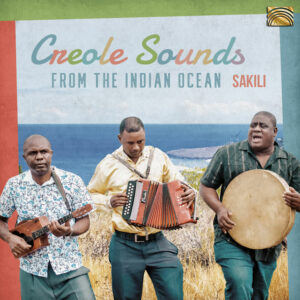
Het Sakili trio komt van het eiland Rodrigues in de Indische Oceaan. Hun debuut-album Creole Sounds From the Indian Ocean is een aaneenschakeling van opzwepende séga en polka muziek met zang, accordeon, percussie en kabosy (soort mandoline uit Madagascar) begeleiding.
English version below
Het eiland Rodrigues werd vernoemd naar de Portugese zeevaarder Diego Rodrigues die het eiland in 1538 ontdekte. En toen begon het; na de Portugesen kwamen de Fransen die er slaven naar toe brachten. Daarna, eind 16de eeuw, probeerden enkele Hugenoten er een Protestante Republiek op te richten dat, door gebrek aan vrouwen, mislukte. Toen kwamen de Britten die er begin 19de eeuw neerstreken. En uiteindelijk werd het kleine eiland zelfstandig in 2002 en wonen er tegenwoordig zo’n 40.000 inwoners. De muziek die er vandaan komt sluit aan bij de séga van Mauritius, weliswaar wat sneller in tempo. Opzwepende muziek met accordeonbegeleiding en zang aangevuld met percussie. De mannen van het Sakili trio schreven veelal hun eigen muziek die nu te vinden is op hun debuut-CD Creole Sounds From the Indian Ocean. Ze zingen over lokale thema’s als de bevolking, politiek, geschiedenis en de liefde. Afzonderlijk hebben de mannen al naam gemaakt op het eiland maar werden bij elkaar gebracht door producer Percy Yip Tong. Hij zorgde ervoor dat het trio kon optreden in Düsseldorf, gevolgd met een tournee door Duitsland, België en Nederland. Dat verliep zo voorspoedig dat Sakili werd opgericht.
Sakili speelt naast de heerlijk dynamische séga. De ritmische en dansbare muziek (in een snelle 6/8ste maat) die veel voorkomt op Madagascar, Mauritius en Rodrigues. Het trio speelt ook de séga tanbour. Een stijl die vooral is bedoeld om te participeren. Meespelen op straat, op het plein, tijdens een feest of thuis; samen muziek maken. Daarnaast horen we enkele polka’s en een (minder geslaagde) blues. Het trio klinkt vrolijk en opgewekt. Organische (meerstemmige) vocalen met veel voor- en nazang. Opzwepende ritmes op framedrum en ferro (metalen percussie) worden strak neergezet door Francis Prosper. Het belangrijkste instrument is de diatonische accordeon die bijna voortdurend aanwezig is. Deze wordt ritmisch bespeeld in de begeleiding en klinkt prachtig in de aanvullende thema’s, innemend gespeeld door Ricardo Legentil. In enkele liedjes klinkt de kabosy: een klein vierkant snaarinstrument waar zowel melodieën (met tremolo) als akkoorden op worden gespeeld door Vallen Pierre Louis. Het geluid doet een beetje denken aan de mandoline en voegt een twinkelend timbre toe. Wie de moeite neemt om het eiland Rodrigues geografisch op te zoeken en de prachtige foto’s te bekijken, moet toegeven dat de ongedwongen schoonheid moeiteloos de spontaniteit van Sakili’s muziek aanvult.
English version
The Sakili trio hails from the island of Rodrigues in the Indian Ocean. Their début album Creole Sounds From the Indian Ocean is a succession of exciting séga and polka music with vocals, accordion, percussion and kabosy (a kind of mandolin from Madagascar).
The island of Rodrigues was named after the Portuguese navigator Diego Rodrigues who discovered the island in 1538. And then it started; after the Portuguese came the French who brought slaves to the island. At the end of the 16th century, some Huguenots tried to establish a Protestant Republic, which failed due to lack of women. Then came the British who settled there at the beginning of the 19th century. And finally, in 2002, the small island became independent and today about 40,000 inhabitants live there. The music from Rodrigues is in line with the séga of Mauritius, although a bit faster in tempo. Uplifting music with accordion accompaniment and vocals supplemented with percussion. The Sakili trio mostly wrote their own music, which can now be found on their debut CD Creole Sounds From the Indian Ocean. They sing about local themes like the population, politics, history and love. The three members became (separate) famous on the island but were brought together by producer Percy Yip Tong. He arranged concerts in Düsseldorf, followed by a tour in Germany, Belgium and the Netherlands. The concerts were such a great succes that they decided to found Sakili.
In addition to the wonderfully dynamic and danceable séga (in a fast 6/8 beat), Sakili also plays the séga tanbour. A style that is primarily intended for participation. Playing in the street, on a square, during a party or at home; making music together. We also hear some polkas and a (less successful) blues. The trio sounds very cheerful. Organic (polyphonic) vocals with lots of call and respond vocals. Exciting rhythms on frame drum and ferro (metal percussion), tightly played by Francis Prosper. The main instrument is the diatonic accordion which is almost constantly present and played rhythmically in the accompaniment and provides beautiful additional themes, played charmingly by Ricardo Legentil. In some songs the kabosy is heard: a small square stringed instrument on which both melodies (with tremolo) and chords are played by Vallen Pierre Louis. The sound is somewhat reminiscent of the mandolin and adds a twinkling timbre. Those who take time to locate the island geographically and view the photos, must admit that the casual beauty is effortlessly reflected in the spontaneity of Sakili’s music. Lovely album!
- Sakili: Creole Sounds From the Indian Ocean (ARC Music / Music&Words)
© Mattie Poels.

Geen reacties